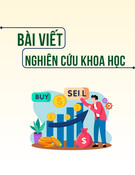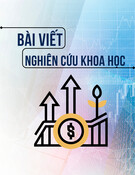
Bibliography 227
Jarque, C.M., and A.K. Bera (1980), “Efficient Tests for Normality,
Homoskedasticity, and Serial Independence of Regression Residuals,”
Economics Letters 6: 255–259.
Judd, Kenneth L. (1998), Numerical Methods in Economics. Cambridge,
MA: MIT Press.
Kantz, H., and T. Schreiber (1997), Nonlinear Time Series Analysis.
Cambridge, UK: Cambridge University Press.
Kirkpatrick, S, C.D. Gelatt Jr., and M.P. Vecchi (1983), “Optimization
By Simulated Annealing,” Science 220: 671–680.
Ko˘cenda, E. (2001) An Alternative to the BDS Test: Integration Across
the Correlation Integral. Econometric Reviews 20, 337–351.
Krugman, Paul (1998), “Special Page on Japan: Introduction.” Webpage:
web.mit.edu/krugman/www/jpage.html.
Kuan, Chung-Ming, and Halbert White (1994), “Artifical Neural Networks:
An Econometric Perspective,” Econometric Reviews 13: 1–91.
Kuan, Chung-Ming, and Tung Liu (1995), “Forecasting Exchange Rates
Using Feedforward and Recurrent Neural Networks,” Journal of
Applied Econometrics 10: 347–364.
Lai, Tze Leung, and Samuel Po-Shing Wong (2001), “Stochastic Neural
Networks with Applications to Nonlinear Time Series.” Journal of
the American Statistical Association 96: 968–981.
LeBaron, Blake (1998), “An Evolutionary Bootstrap Method for Selecting
Dynamic Trading Stratergies”, in A.-P. N. Refenes, A.N. Burgess and
J.D. Moody (eds.), Decision Technologies for Computational Finance,
Ansterdam: Kluwer Academic Publishers, 141–160.
Lee, T.H., H. White, and C.W.J. Granger (1992), “Testing for Neglected
Nonlinearity in Times Series Models: A Comparison of Neural Network
Models and Standard Tests,” Journal of Econometrics 56: 269–290.
Ljung, G.M., and G.E.P. Box (1978), “On a Measure of Lack of Fit in
Time Series Models.” Biometrika 65: 257–303.
Lumsdaine, Robin L., and D. H. Papell (1997), “Multiple Trend Breaks
and the Unit Root Hypothesis,” Review of Economics and Statistics:
212–218.
Mandic, Danilo, and Jonathan Chambers (2001), Recurrent Neural
Networks for Prediction: Learning Algorithms, Architectures, and
Stability. New York: John Wiley and Sons.

228 Bibliography
McCarthy, Patrick S. (1996), “Market Price and Income Elasticities of
New Vehicles,” Review of Economics and Statistics 78: 543–548.
McKibbin, Warwick (2002), “Macroeconomic Policy in Japan,” Asian
Economic Paper 1: 133–169.
———, and Peter Wilcoxen (1998), “The Theoretical and Empiri-
cal Structure of the G-Cubed Model,” Economic Modelling 16:
123–148.
McLeod, A. I., and W.K. Li (1983), “Diagnostic Checking of ARMA Time
Series Models Using Squared-Residual Autocorrelations,” Journal of
Time Series Analysis 4: 269–273.
McNelis, P., and G. Nickelsburg (2002), “Forecasting Automobile Produc-
tion in the United States.” Manuscript, Economics Dept., Georgetown
University.
McNelis, Paul D., and Peter McAdam (2004), “Forecasting Inflation with
Thick Models and Neural Networks.” Working Paper 352, European
Central Bank. Webpage: www.ecb.int/pub/wp/ecbsp352.pdf.
Meltzer, Alan (2001), “Monetary Transmission at Low Inflation: Some
Clues from Japan,” Monetary and Economic Studies 19(S-1): 13–34.
Merton, Robert (1973), “An Intertemporal Capital Asset Pricing Model.”
Econometrica 41: 867–887.
Metropolis, N., A.W. Rosenbluth, M. N. Rosenbluth, A.H. Teller, and
E. Teller (1953), “Equation of State Calculations by Fast Computing
Machines,” Journal of Chemical Physics 21: 1087–1092.
Michalewicz, Zbigniew (1996), Genetic Algorithms + Data Structures =
Evolution Programs. Third Edition. New York: Springer-Verlag.
———, and David B. Fogel (2002), How to Solve It: Modern Heuristics.
New York: Springer-Verlag.
Miller, W. Thomas III, Richard S. Sutton, and Paul J. Werbos (1990),
Neural Networks for Control. Cambridge, MA: MIT Press.
Neft¸ci, Salih (2000), An Introduction to the Mathematics of Financial
Derivatives. San Diego, CA: Academic Press.
Perron, Pierre (1989), “The Great Crash, the Oil Price Shock, and the
Unit Root Hypothesis,” Econometrics 57: 1361–1401.

Bibliography 229
Pesaran, M.H., and A. Timmermann (1992), “A Simple Nonparametric
Test of Predictive Performance,” Journal of Business and Economic
Statistics 10: 461–465.
Qi, Min (1999), “Nonlinear Predictability of Stock Returns Using Finan-
cial and Economic Variables,” Journal of Business and Economics
Statistics 17: 419–429.
Quagliarella, Domenico, and Alessandro Vicini (1998), “Coupling Genetic
Algorithms and Gradient Based Optimization Techniques,” in
Quagliarella, D., J. Periaux, C. Poloni, and G. Winter (eds.), Genetic
Algorithms and Evolution Strategy in Engineering and Computer
Science: Recent Advances and Industrial Applications. West Sussex,
England: John Wiley and Sons, Ltd.
Quagliarella, D., J. Periaux, C. Poloni, and G. Winter (1998), Genetic
Algorithms and Evolution Strategy in Engineering and Computer
Science: Recent Advances and Industrial Applications. West Sussex,
England: John Wiley and Sons, Ltd.
Razzak, Weshah A. “Wage-Price Dynamics, the Labor Market, and
Deflation in Hong Kong.” HKIMR Working Paper 24/2003.
Rissanen, J. (1986a), “A Predictive Least-Squares Principle,” IMA Journal
of Mathematical Control and Information 3: 211–222.
——— (1986b), “Stochastic Complexity and Modeling,” Annals of
Statistics 14: 1080–1100.
Robinson, Guy (1995), “Simulated Annealing.” Webpage:
www.npac.syr.edu/ copywrite/pcw/node252.
Ross, S. (1976), “The Arbitrage Theory of Capital Asset Pricing,” Journal
of Economic Theory 13: 341–360.
Rustichini, Aldo, John Dickhaut, Paolo Ghirardato, Kip Smith, and Jose
V. Pardo (2002), “A Brain Imaging Study of Procedural Choice,”
Working Paper, Department of Economics, University of Minnesota.
Webpage: http://www.econ.umn.edu/˜arust/ProcCh3.pdf.
Sargent, Thomas J. (1997), Bounded Rationalilty in Macroeconomics.
Oxford: Oxford University Press.
——— (1999), The Conquest of American Inflation. Princeton, NJ:
Princeton University Press.

230 Bibliography
Schwarz, G. (1978), “Estimating the Dimension of a Model,” Annals of
Statistics 6: 461–464.
Sims, Christopher (1992), “Interpreting the Macroeconomic Times Series
Facts: The Effects of Monetary Policy.” European Economic Review
36: 2–16.
———, and Mark W. Watson (1998), “A Comparison of Linear and
Nonlinear Univariate Models for Forecasting Macroeconomic Time
Series.” Cambridge, MA: National Bureau of Economic Research
Working Paper 6607. Website: www.nber.org/papers/w6607.
Stock, James H., and Mark W. Watson (1999), “Forecasting Inflation,”
Journal of Monetary Economics 44: 293–335.
Sundermann, Erik (1996), “Simulated Annealing.” Webpage: petaxp.rug.
ac.be/˜erik/research/research-part2.
Svensson, Lars E. O., (2003), “Escaping from a Liquidity Trap and
Deflation: The Foolproof Way and Others,” Journal of Economic
Perspectives.
Ter¨asvirta, T. (1994), “Specification, Estimation, and Evaluation of
Smooth-Transition Autogressive Models,” Journal of the American
Statistical Association 89: 208–218.
———, and H.M. Anderson (1992), “Characterizing Nonlinearities in
Business Cycles Using Smooth Transition Autoregressive Models,”
Journal of Applied Econometrics 7: S119–S136.
van Dijk, Dick, Timo Ter¨asvirta, and Philip Hans Franses (2000),
“Smooth Transition Autoregressive Models—A Survey of Recent
Developments.” Research Report EI2000–23A. Rotterdam: Erasmus
University, Econometric Institute.
Tsay, Ruey S. (2002), Analysis of Financial Time Series. New York: John
Wiley and Sons, Inc.
van Laarhoven, P.J.M., and E.H.L. Aarts (1988), Simulated Annealing:
Theory and Applications. Boston, MA: Kluwer Academic Publishers.
Werbos, Paul John (1994), The Roots of Backpropagation: From Ordered
Derivatives to Neural Networks and Political Forecasting. New York:
Wiley Interscience.
White, Halbert (1980), “A Heteroskedasticity Covariance Matrix and a
Direct Test for Heteroskedasticity.” Econometrica 48: 817–838.

Bibliography 231
Wolkenhauer, Olaf (2001), Data Engineering. New York: John Wiley and
Sons.
Yoshino, Naoyuki and Eisuke Sakakibara (2002), “The Current State of
the Japanese Economy and Remedies,” Asian Economic Papers 1:
110–126.
Zivot, E., and D.W.K. Andrews (1992), “Further Evidence on the Great
Crash, the Oil Price Shock, and the Unit-Root Hypothesis,” Journal
of Business and Statistics 10: 251–270.







![Bảng kê mua vào không có hóa đơn: [Hướng dẫn/Mẫu] chi tiết](https://cdn.tailieu.vn/images/document/thumbnail/2019/20190620/nguyenyenyn117/135x160/4891560998594.jpg)


















